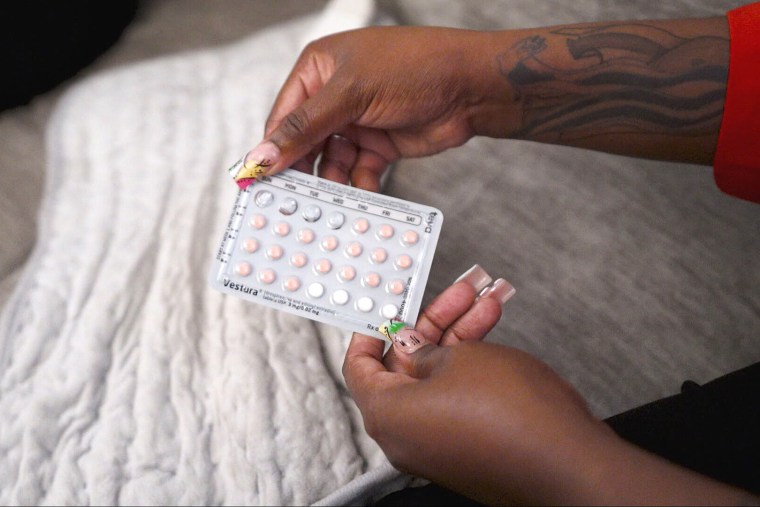WESTLAND, Mich. — For D’Asia Jackson, every day is a guessing game over whether excruciating pain will upend her life.
The 28-year-old medical assistant was born with sickle cell disease, an inherited condition that causes red blood cells to be shaped like a crescent moon. The anomaly can cause blood clots, organ damage and excruciating pain, which can worsen during the menstrual cycle.
“Pain-wise, I always describe it as like being hit by a Mack truck,” Jackson said. “When I know my period is coming, I know pain is probably right behind it.”
Over the last 10 years, Jackson has worked with her doctors to try a variety of contraception options to get her symptoms under control, from the Depo-Provera shot, a hormone injection given every three months, to an IUD to different forms of birth control pills.
According to Jackson, none of them helped. Some made her periods even worse.
“I might have a good four or five good days of not bleeding in a month,” she said. “Over the years, it’s like the period actually started getting heavier, and that’s when it started affecting my sickle cell.”
At times, she’s ended up in the hospital needing iron infusions due to loss of blood. Doctors don’t know how to manage her symptoms. Sickle cell has no cure and treatment options are variable.
“The lack of education on sickle cell is very frustrating,” she said. “I go into hospital stays having to educate doctors and nurses.”

Now, women like Jackson are worried that lack of knowledge, particularly about how contraception affects their conditions, could get worse.
In April, a small team that compiled information into what some consider the country’s “contraception bible,” a set of guidelines used by physicians to assess which types of birth control are safe for their patients, was fired from the Centers for Disease Control and Prevention as part of mass layoffs from the agency. The eight-person team was responsible for evaluating research and recommending birth control methods for patients with various conditions, from sickle cell disease, kidney disease and lupus to those at risk for HIV.
The guidelines, called the U.S. Medical Eligibility Criteria for Contraceptive Use, provided the latest research for doctors, including an app that recommended which contraceptive methods were safe.
The app has been downloaded more than 440,000 times, according to the CDC.
Now, the work of that team has been halted as part of the reduction of the Women’s Health and Fertility Branch of the Division of Reproductive Health.
“These are the only federal guidelines that focus on the safety of contraception for women with certain medical conditions,” said Lee Warner, the former chief of the Women’s Health and Fertility Branch. “This work exists nowhere else, and these individuals specialize in this area. Without their presence, the work stops.”
Warner retired from the agency in April just after learning his team was being eliminated.
“While most women are able to use most methods, we looked at 60 conditions and over 1,800 evidence-based recommendations across an array of contraceptive methods,” he said. “For some women, it is very dangerous for them to become pregnant at a certain point. So having contraception available to them that they can choose can help protect them.”
At least 90% of people in the United States with sickle cell disease are Black. The maternal mortality rate for Black sickle cell patients has been found to be 26 times higher than for non-Black people.
“The CDC’s decision to cut the team responsible for contraceptive guidelines is especially troubling for the sickle cell community, where pregnancy can carry severe health risks,” said Teonna Woolford, who founded the nonprofit Sickle Cell Reproductive Health Education Directive to advocate for patients and expand knowledge about the often-misunderstood disease. “Eliminating this resource will disproportionately impact a community already facing significant barriers to care, further deepening health disparities.”
In response to a request for comment, an official for the Department of Health and Human Services did not explain why the team was cut.
In May, Health Secretary Robert F. Kennedy Jr. defended the cuts in a hearing before the Senate Health, Education, Labor and Pensions Committee.
“Right now we have 42 divisions that do maternal health,” Kennedy testified. “They’re not cuts. They’re consolidations. It’s ridiculous to have 42 divisions that are all supposed to be doing the same thing.”
Warner disagreed with Kennedy’s testimony.
“Especially with this branch,” he said, “the expertise is not redundant of that elsewhere in the federal government.”
“Once this expertise is gone, it is permanently gone from the agency. It is going to be very hard to resume and re-create,” he said.

“The HHS restructuring consolidates maternal and child health programs into the new Administration for a Healthy America (AHA) to improve efficiency and better address public health needs,” an HHS official said in a statement to NBC News. “The reorganization aims to streamline operations, maximize resources, and support key priorities like maternal mental health and data collection. We remain committed to improving health outcomes for American families.”
Representatives for HHS did not specify if work on the contraception guidelines would continue. The Trump administration did not respond to questions about why the team was cut or if its work would continue.
The CDC’s most recent update to the contraception guidelines was published in August.
The updates included new recommendations for people with sickle cell disease, finding that combined hormonal contraception presents an “unacceptable health risk” due to patients’ risk of life-threatening blood clots. In previous versions of the guidelines, the CDC found the advantages of combined hormonal birth control, which contains estrogen and progestin, outweighed potential risks such as blood clots or stroke. The newest guidelines also increased the risk category for the Depo-Provera shot, while ranking methods like progestin-only pills and IUDs as generally safe.
Jackson was unaware of the updated guidance until her interview with NBC News.
She said she is using an IUD as well as combined hormonal contraception in the form of a pill to try to manage her bleeding.
“I didn’t know that,” she said. “I kind of just hope that my doctor knows a lot and kind of just steers me in the right direction.”
Warner said the CDC team should be publicizing the updated guidance now to make physicians aware of the changes and adjust how they treat patients.
“We actually planned to do a road show of the guidelines in the late fall and throughout the spring in which we would disseminate the guidelines and go speak to provider groups,” he said. “It’s not happening.”
The severe pain associated with her periods has driven Jackson to seek a hysterectomy for relief.
“I have been asking for a hysterectomy for years. I’ve seen five different OBs, and no one will do it,” she said.
While the current guidelines are still accessible, the August update could be the last, leaving Jackson with little hope that she’ll find a method of birth control that works for her.
“I am terrified of how health care is going to go with all of these cuts being made,” she said.
